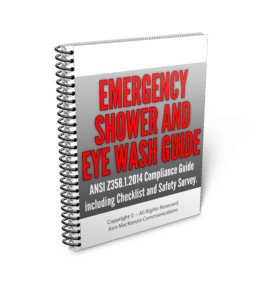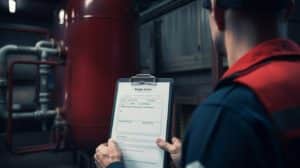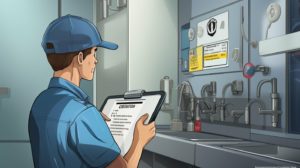
One critical aspect of workplace safety is eyewash stations, which can help prevent eye injuries and save lives in case of an emergency.
However, simply having an eyewash station in the workplace is not enough. Regular inspection and maintenance of the equipment are essential to ensure it is functioning correctly and meets safety standards.
In this section, we will provide you with an essential eyewash station checklist guide that will help you maintain safety compliance while keeping your employees safe from eye injuries.
This guide will cover everything from understanding eyewash station regulations to emergency eyewash procedures, best practices for inspections, and a comprehensive checklist that can be used during inspections.

Special Offer $27.00. Click on Image and instantly download this 51 Page Guide in PDF format
As part of ensuring workplace safety, it’s crucial for businesses to adhere to specific regulations regarding eyewash stations. These regulations are set by both the Occupational Safety and Health Administration (OSHA) and the American National Standards Institute (ANSI).
OSHA eyewash regulations: OSHA mandates that eyewash stations must be easily accessible and located within a 10-second walk of any hazardous work area. There must also be a clear path to the eyewash station, and it must be free of obstructions.
ANSI eyewash standards: ANSI standards provide specific requirements for eyewash equipment, including the length and diameter of the nozzles, water temperature, and water flow rate. Additionally, ANSI requires that eyewash stations be inspected and tested on a weekly basis to ensure compliance with these standards.
It’s important for businesses to understand these regulations and implement them to ensure the safety of their employees. Failure to comply with these regulations can result in serious consequences, including fines and legal action.
“OSHA mandates that eyewash stations must be easily accessible and located within a 10-second walk of any hazardous work area.”
“ANSI requires that eyewash stations be inspected and tested on a weekly basis to ensure compliance with these standards.”
Regular maintenance is crucial in ensuring the proper functionality and effectiveness of eyewash stations. Employers must ensure that their eyewash stations are checked and maintained regularly, and failure to do so can result in serious consequences for employees.
To keep your eyewash station in optimal condition, consider following this maintenance eyewash station checklist:
| Task | Frequency |
|---|---|
| Inspect the eyewash station for any damage or wear and tear | Weekly |
| Ensure that the eyewash nozzles are clean and free of any debris | Weekly |
| Check that there is a sufficient supply of sterile water or saline solution available | Weekly |
| Activate the eyewash station to ensure that it flows smoothly and consistently | Monthly |
| Check the expiration date on any saline solutions or other eyewash fluids and replace as needed | Monthly |
| Conduct a thorough cleaning of the eyewash station, including the basin and nozzles | Quarterly |
| Test the water temperature to ensure that it is within the acceptable range (between 60-100°F or 16-38°C) | Quarterly |
It is important to document all maintenance checks and any repairs or replacements that are made. Regular maintenance and record-keeping will help to ensure that your eyewash station is always in compliance with regulations and ready to use in case of an emergency.
Remember: Proper maintenance of your eyewash station can save your employees from serious eye injuries.

In case of an eye emergency, quick and proper action is critical. Here are the step-by-step procedures to follow:
Remember, only trained personnel should handle eye emergencies. Make sure your employees know what to do in case of an eye emergency. Proper training is essential to avoid further injuries and ensure the best possible outcome.
Regular inspections of eyewash stations are crucial for ensuring the safety and well-being of employees. To ensure your inspections are thorough and effective, consider these best practices:
By adhering to these best practices, you can help ensure that your eyewash station inspections are effective, efficient, and compliant with regulations.
Ensuring compliance with eyewash station regulations is crucial for maintaining a safe working environment. Non-compliance can result in serious consequences, including fines and legal action.
Businesses should make it a priority to stay up to date with OSHA and ANSI regulations regarding eyewash stations. Regular audits should be conducted to identify any non-compliance issues and take corrective action immediately.
Record-keeping is an essential component of eyewash station compliance. Businesses should maintain detailed records of eyewash station inspections, maintenance, and employee training. These records should be easily accessible in case of an audit or inspection.
If a non-compliance issue is identified during an inspection, it should be immediately addressed. This includes taking corrective action as soon as possible and documenting the steps taken to resolve the issue.
Regular employee training is also crucial for maintaining compliance with eyewash station regulations. All employees who may come into contact with hazardous materials should receive comprehensive training on emergency eyewash procedures and the use of eyewash stations.
By staying compliant with eyewash station regulations, businesses can ensure the safety of their employees and avoid costly legal repercussions.
Providing proper training to employees is one of the most critical steps in ensuring the safety and effectiveness of eyewash stations. As an employer, it is your responsibility to offer comprehensive training on the proper use of eyewash equipment and emergency procedures in case of eye injuries.
Training should cover the following key elements:
It is essential to provide ongoing training and refresher courses to employees to ensure they remain up-to-date with any changes in eyewash station regulations or equipment.
By prioritizing eyewash station safety training for your employees, you can prevent serious eye injuries and create a safer work environment for all.

When conducting an eyewash station checklist inspection, it is essential to follow a comprehensive checklist to ensure that the equipment is functional, accessible, and compliant with OSHA and ANSI standards. Use the following eyewash station checklist to perform a thorough inspection:
| Checklist Item | Description |
|---|---|
| Location | Is the eyewash station located within 10 seconds or 55 feet of the hazard? |
| Accessibility | Is the eyewash station unobstructed, visible, and clearly identified with signage? |
| Water Temperature | Is the water temperature between 60°F and 100°F? |
| Water Flow | Is the water flow sufficient to provide a 15-minute flush? |
| Nozzles and Covers | Are the nozzles clean, unobstructed, and functioning properly? Are the covers in place? |
| Drainage | Is the drainage clean and unobstructed? |
| Maintenance | Have any maintenance issues been identified and addressed? |
| Employee Training | Have employees received proper training on how to use the eyewash station? |
By following this checklist, you can ensure that your eyewash station is in compliance with relevant regulations and is functioning properly to protect the health and safety of your employees.
Note: Make sure to keep a record of all inspections and maintenance tasks performed on the eyewash station.
Regular inspections of eyewash stations are crucial for maintaining a safe working environment and complying with OSHA and ANSI regulations. By implementing the essential eyewash station checklist provided in this guide, businesses can ensure that their eyewash equipment is functioning properly and accessible to employees in case of an eye emergency.
It is important to remember that eyewash station maintenance goes beyond just routine inspections. Proper upkeep and maintenance of equipment is necessary to ensure that it is effective when needed the most. Additionally, providing adequate training to employees on eyewash safety procedures is essential to prevent potential injuries.
Incorporating these best practices into a company’s safety plan can help ensure that they remain in compliance with eyewash station regulations and create a safe work environment for all employees. If you have any questions or concerns about eyewash station checklist inspections, seek further guidance from a qualified professional.
Eyewash station inspection is crucial for ensuring the safety and well-being of employees. Regular inspections help identify any issues or malfunctions in the equipment, ensuring that it is ready for immediate use in case of an eye emergency.
Eyewash stations must comply with the regulations set by OSHA and ANSI. These standards outline the requirements for equipment design, location, accessibility, water temperature, and flow rate to ensure effective and proper eye flushing.
Regular maintenance is essential for eyewash stations. This includes tasks like checking water quality, testing water flow, cleaning nozzles, and ensuring proper functioning of the unit. Maintenance should be performed according to a schedule to prevent any potential issues.
In case of an eye emergency, eyewash station procedures should be followed. This includes activating the eyewash station immediately, allowing water to flush the eyes for a recommended duration, and seeking medical assistance for further evaluation and treatment.
When conducting eyewash station checklist inspections, it is recommended to follow best practices. These include conducting inspections at regular intervals, documenting findings, training employees responsible for inspections, and addressing any potential issues promptly.
Businesses can ensure compliance by maintaining thorough records of inspections, performing regular audits of eyewash stations, addressing any non-compliance issues promptly, and staying up to date with any changes in regulations related to eyewash stations.
Proper training on eyewash station safety is vital for employees. Training should cover topics such as recognizing eye hazards, understanding the use of eyewash stations, and knowing the correct procedures to follow in case of an eye emergency. Regular refresher courses should also be provided.
The inspection checklist for eyewash stations should cover various components, including checking equipment functionality, verifying proper location and signage, ensuring accessibility, assessing water quality and temperature, and confirming emergency contact information is visible.
The information provided in this eyewash station checklist article is for informational purposes only and should not be considered as professional advice. Always consult qualified professionals for specific safety recommendations and guidance for your workplace.
As an Amazon Affiliate, I earn from qualifying purchases. SafetyShowerSystems.com is a participant in the Amazon Services LLC Associates Program, an affiliate advertising program designed to provide a means for sites to earn advertising fees by advertising and linking to Amazon.com,
Links on this Eyewash Station Checklist Osha page are sponsored affiliate links and the owner makes a commission if you buy after clicking these links. The owner is not a bonafide user of an eyewash station checklist Osha However, he has thoroughly researched the Eyewash station checklist and provided a personal opinion only. This disclosure is in accordance with the Federal Trade Commission’s 16 CFR, Part 255: “Guides Concerning the Use of Endorsements and Testimonials in Advertising.”